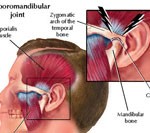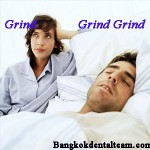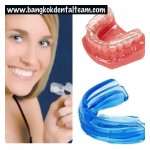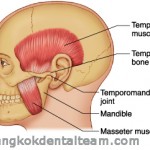-
Occlusion & Temporomandibular Disorders (TMD)
Occlusion and Temporomandibular Disorders
Your tooth and gum are very important, so do your muscles of
mastication, and jaw joints. Sometimes, some people grind their
teeth at night time. This can result in tooth wear, pain in muscles
of mastication and jaw joints. If you are one of those who suffer
from this problem, please do not hesitate to meet our specialist
Dental Occlusion or Malocclusion is an extremely common dental condition caused when the biting surfaces of the teeth do not properly fit together. The way teeth grow out of the jaw is influenced by a number of factors, as heredity, shape of the jaw, and certain environmental conditions can lead to uneven variations in biting surface. If left untreated these variations in jaw structure can eventually cause problems with biting, gum health, speech development, and the ability to maintain proper oral hygiene.
Most dental occlusion are treated after adult teeth begin to grow in, as the bones and teeth are far more pliable than those of adults. In some cases the dentist will have to remove one or more permanent teeth to ensure proper growth and expansion of other teeth. Great care is exercised to prevent future impaction or irritation by other teeth that have yet to erupt, so many people who have malocclusion are required to wear a retaining device or mouthpiece to prevent complications.
Bruxism
Bruxism is the technical term for grinding and clenching that abrades teeth and may cause facial pain. People who grind and clench, called bruxers, unintentionally bite down too hard at inappropriate times, such as in their sleep.
People who have otherwise healthy teeth and gums can clench so often and so hard that over time their teeth become sensitive. They experience jaw pain, tense muscles and headaches along with excessive wear on their teeth. Forceful biting when not eating may cause the jaw to move out of proper balance.
Temporomandibular disorders (TMD)
Temporomandibular disorders (TMD) occur as a result of problems with the jaw, jaw joint and surrounding facial muscles that control chewing and moving the jaw. These disorders are often incorrectly called TMJ, which stands for temporomandibular joint.
What Is the Temporomandibular Joint (TMJ)?
The temporomandibular joint (TMJ) is the hinge joint that connects the lower jaw (mandible) to the temporal bone of the skull, which is immediately in front of the ear on each side of your head. The joints are flexible, allowing the jaw to move smoothly up and down and side to side and enabling you to talk, chew, and yawn. Muscles attached to and surrounding the jaw joint control the position and movement of the jaw.
What Causes TMD?
The cause of TMD is not clear, but dentists believe that symptoms arise from problems with the muscles of the jaw or with the parts of the joint itself.
Injury to the jaw, temporomandibular joint, or muscles of the head and neck – such as from a heavy blow or whiplash – can cause TMD. Other possible causes include:
– Grinding or clenching the teeth, which puts a lot of pressure on the TMJ
– Dislocation of the soft cushion or disc between the ball and socket
– Presence of osteoarthritis or rheumatoid arthritis in the TMJ
– Stress, which can cause a person to tighten facial and jaw muscles or clench the teeth
Common symptoms of TMD include:
Pain or tenderness in the face, jaw joint area, neck and shoulders, and in or around the ear when you chew, speak, or open your mouth wide
– Limited ability to open the mouth very wide
– Jaws that get “stuck” or “lock” in the open- or closed-mouth position
– Clicking, popping, or grating sounds in the jaw joint when opening or closing the mouth (which may or may not be accompanied by pain) or chewing
– A tired feeling in the face
– Difficulty chewing or a sudden uncomfortable bite – as if the upper and lower teeth are not fitting together properly
– Swelling on the side of the face
– May occur on one or both sides of the face
Other common symptoms of TMD include toothaches, headaches, neck aches, dizziness, earaches, hearing problems, upper shoulder pain, and ringing in the ears (tinnitis).
| S | M | T | W | T | F | S |
|---|---|---|---|---|---|---|
| « Aug | ||||||
| 1 | 2 | 3 | 4 | 5 | 6 | |
| 7 | 8 | 9 | 10 | 11 | 12 | 13 |
| 14 | 15 | 16 | 17 | 18 | 19 | 20 |
| 21 | 22 | 23 | 24 | 25 | 26 | 27 |
| 28 | 29 | 30 | ||||
Tags
beautiful
Bleaching
braces
cleaning
damon
dental
Dental Implant
dental implants
dental substitution
denture
Endodontics
fixed denture
gum
Implants
orthodontics
Orthodontics
smile
teeth
Teeth Bleaching
Teeth Whitening
treatment
veneers
Whitening
ขูดหินปูน
ครอบฟัน
จัดฟันดาม่อน
จัดฟันเพื่อสุขภาพฟันที่ดี
ดัดฟัน
ดามอน
ทำความสะอาดฟัน
ปรึกษา
ฟอกสีฟัน
ฟันขาว
ฟันปลอม
ฟันปลอมติดแน่น
ฟันสวย
ฟันสีขาว
ยิ้มสวย
รากเทียม
วีเนียร์
สีฟัน
เคลือบฟันเทียม
เสียวฟัน
ใส่ฟัน
ใส่ฟันปลอม





